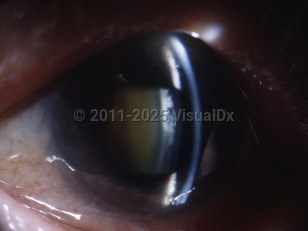Acute angle-closure glaucoma - External and Internal Eye
Alerts and Notices
Important News & Links
Synopsis

An attack of acute ACG occurs when there is a sudden obstruction of aqueous humor outflow through the drainage angle of the eye, causing a rapid increase in intraocular pressure (IOP). Primary angle closure may be caused by pupillary block or angle crowding or both. Pupillary block occurs when the increased iris convexity brings the iris into apposition with the trabecular meshwork, thereby blocking drainage of the aqueous fluid. With angle-crowding mechanism, anteriorly positioned ciliary processes push the iris anteriorly so that the peripheral iris lies against the trabecular meshwork. Secondary angle closures are associated with angle blockage from other ocular diseases such as iris neovascularization, uveitis, trauma, tumors, ectopic lens, cataract, or lens protein leakage.
Patients often present with acute onset of extremely painful, decreased vision associated with a red eye and a mid-dilated pupil. Headache, seeing rainbow-colored halos around lights, nausea, and vomiting are also commonly present. There may be a recent history of physiologic (ie, being in a dark room) or pharmacologic pupillary dilation.
Codes
H40.219 – Acute angle-closure glaucoma, unspecified eye
SNOMEDCT:
30041005 – Acute angle-closure glaucoma
Look For
Subscription Required
Diagnostic Pearls
Subscription Required
Differential Diagnosis & Pitfalls

Subscription Required
Best Tests
Subscription Required
Management Pearls
Subscription Required
Therapy
Subscription Required
Drug Reaction Data
Subscription Required
References
Subscription Required
Last Updated:08/22/2019

